History of Fountains Abbey and Studley Royal
- Expert curated

Jump to
The ruins at Fountains Abbey are the largest monastic ruins in the country. Step back into a rich and dramatic past and imagine what life would have been like for the monks who first came here years ago, and learn how Fountains Abbey and Studley Royal became one.
Introduction
Fountains Abbey and Studley Royal in North Yorkshire is a place with a complex history spanning almost 900 years. Fountains Abbey was a Cistercian house established in 1132 but was ruined after the Dissolution of the Monasteries in 1539. In the 18 century, it was incorporated into the designed landscape of Studley Royal, the creation of John Aislabie and his son William. The result is a designed landscape of great beauty and ingenuity that welcomed visitors almost as soon as it was begun. It was recognised as a World Heritage Site in 1986.
Fountains Abbey
13 Benedictine monks founded the Abbey in 1132. They had left St Mary’s in York seeking seclusion to dedicate their lives to God. The Archbishop of York gave them a site deep in the Skell valley to found their new Abbey. It was remote, but it had access to natural resources, including water, wood, stone and earth. Three years later the Abbey was accepted into the Cistercian Order.
Fountains Abbey rose to become the largest and richest abbey in the north of England. The choir monks lived in the Abbey and followed the rule of St Benedict; they adopted a life of simplicity, solitude and austerity. The lay brothers, who also lived in the Abbey, were not monks but provided labour to ensure that it ran smoothly. This allowed the monks to spend their time in prayer and worship. During the 400 years that the Abbey was a religious site, its wealth and power grew, only to end abruptly in 1539 with the Dissolution of the Monasteries under Henry VIII. The Abbey was subsequently used as a stone quarry, adding to its ruinous state.
The Fountains Abbey Estate
The Crown sold the Abbey buildings and 500 acres of land to a merchant, Sir Richard Gresham (c.1485–1549) in 1540. He began stripping the Abbey of valuable materials, initiating the ruin of the religious buildings.
In around 1600 the next owner, Sir Stephen Proctor, commissioned the building of a new house, Fountains Hall, on the site of the Abbey stables, partly using material from the ruins of the Abbey. It was the main house on the Fountain Abbey estate until 1767, when it became a part of the Studley Royal Estate. After this it had various uses including accommodation for estate families, offices and storage.
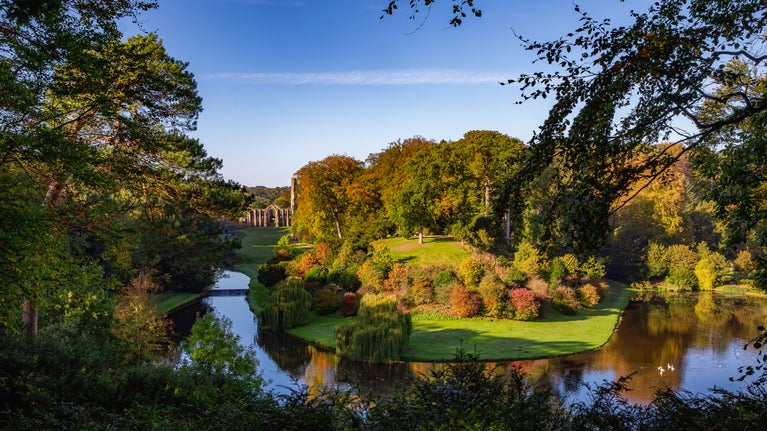
Idleness is the enemy of the soul. For this reason the brethren should be occupied at certain times in manual labour and at other times in sacred reading.
Studley Royal House
Studley Royal House was a medieval house located in the deer park about half a mile from what is today the canal gates entrance to the Studley Royal Garden.
In 1699, John Aislabie (1670–1742) inherited Studley Royal House from his mother’s family. The house was refurbished by John after it was damaged by fire in 1716, before it was remodeled in a classical style during the 1740s. In the 1750s, his son, William (c.1700–81), commissioned fine internal plasterwork by master stuccoist, Guiseppe Cortese of York. Gothic features were also added externally. Studley Royal House was destroyed by fire in 1946, and today little evidence of the building remains above ground.
John Aislabie and the South Sea Company
John Aislabie was an ambitious political man. At the age of 25 he became the Member of Parliament for Ripon and by 1718 became the Chancellor of the Exchequer in the new Whig administration.
Aislabie was also one of the principal sponsors of the South Sea Company, a joint-stock company which sold bonds to provide funding for the British government. The company was created principally to supply enslaved people to work on Spanish plantations in the Americas. In 1720 the company collapsed, many investors were bankrupted and, since Aislabie was held responsible, he was fined the huge sum of £45,000 and temporarily imprisoned in the Tower of London. As Aislabie owned Studley Royal prior to his deception, he was afforded a dispensation allowing him to keep the property he possessed prior to 1718. After his release, he retired from political life to Studley Royal, where he focused on the transformation of his gardens which had begun in 1718.
Creating the Studley Royal Designed Landscape
John Aislabie began altering the landscape around the Studley Royal Estate after he became Chancellor of the Exchequer in 1718. When his son William inherited in 1742, he continued to transform the landscape. The designed landscape included the Deer Park, the Water Garden, the ruins of Fountains Abbey itself and extended beyond to gardens that no longer exist today.
The Aislabies created this landscape by manipulating nature. They planted extensively to hide and expose views. They altered the water course of the river Skell, creating ponds, lakes and cascades. The result is one of the most magnificent water gardens ever created.
They designed the garden to express meaning – symbolic, political and ideological. These political references, which we may miss today, would have been clear to the 18th-century visitor. For instance, the decision to grow the Scots pine might suggest support for the Jacobite cause. The decision to name a part of the garden, Quebec, celebrated General Wolfe and the British victory over the French in Canada.
The garden is designed to delight. Walking through the garden, visitors come across views of different features, natural and manmade. This can surprise visitors today as it may have done in the 18th century. When John Aislabie first laid out the gardens, they ‘borrowed’ a view to the abbey ruins. In 1767, his son Willam bought the Fountains Abbey Estate, and was able to fully incorporate the Abbey ruins into the garden.
All of the features in this landscape were the height of fashion in the early 18th century, and they became part of the journey around the garden to impress those who visited. During the 18th century, the gardens and the house, like many others in Britain, were open to ‘respectable’ people who called and requested access.

The Marquess of Ripon
George Robinson, 2nd Viscount Goodrich (1827–1909) inherited Studley Royal in 1859. Robinson first entered the House of Commons as the Whig (Liberal) Member of Parliament for Hull in 1852. From 1859, when he took his place in the House of Lords, he was given ministerial responsibility. As Lord President of the Council, Robinson chaired the commission which drew up the Treaty of Washington. This treaty compensated the United States for the fact that the British had supplied ships to the Confederate Navy during the American Civil War.
Following the success of this treaty he was created the Marquess of Ripon in 1871. The same year, he commissioned architect William Burges to build St Mary’s church in the Deer Park. The Gothic Revival church, completed in 1878, is an architectural masterpiece and one of Burges’s most notable works.
In 1880 Robinson became Viceroy of India, where he attempted but failed to pass legislation which would grant more rights to Indian Judges. When his son, Frederick Robinson, 2nd Marquess of Ripon, died without children in 1923, Studley Royal estate was acquired by a cousin and the title died out.
The 19th century
The number of visitors to Studley Royal and Fountains Abbey continued to grow in the 19th century, with the development of railways, the commercialisation of tourism and the advent of affordable travel.
The 20th century
In the 20th century the Vyner family became the last private owners of the Studley Royal Estate, which included Fountains Abbey. In the 1920s they refurbished Fountains Hall as their home. During the Second World War they let Studley Royal House to Queen Ethelburga’s School. It was soon after the school left in 1946 that the house was gutted by fire and demolished.
In 1952, the Queen Mother dedicated a memorial to brother and sister Charles and Elizabeth and Vyner, who lost their lives in the Second World War. Some of the abbey’s ancillary buildings continued to be used. The most notable example is Fountains Mill which was used productively for corn milling, timber processing and other minor industries until 1927. The Vyners sold the estate in the 1960s.
West Riding Council acquired Studley Royal and Fountains Abbey between 1966–9 (when they also bought Fountains Hall). The National Trust acquired the site in 1983.
The National Trust
In1986 the site was granted World Heritage Site status. This accolade recognises the site as an outstanding example of the English garden style, which demonstrates the evolving tastes of the 18th century in one landscape.
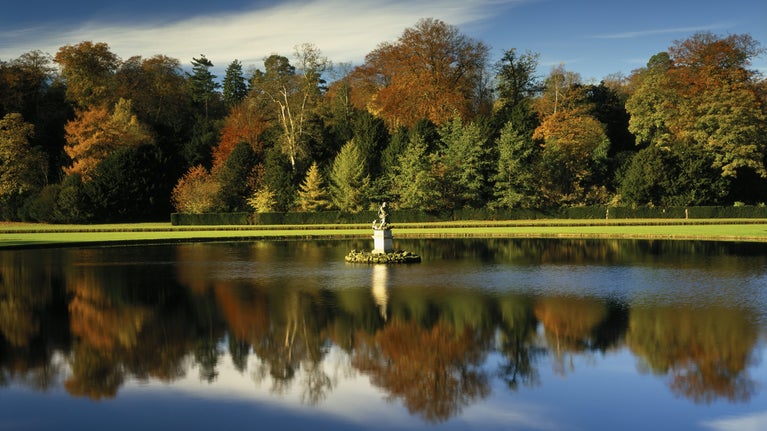
Further reading
If you wish to continue journeying through the history of Fountains Abbey and Studley Royal, you'll be able to read on using the reading list below.
- Collinson, Catherine, ‘Proctor, Stephen.’ Oxford Dictionary of National Biography, 3 January 2008
- Coppack, G., Fountains Abbey, English Heritage and Batsford Ltd. 1993
- Newman, Mark, The Wonder of the North: Fountains Abbey and Studley Royal, Boydell Press with the National Trust. 2015
- Paul, Helen Julia, The South Sea Bubble: an economic history of its origins and consequences, Routledge. 2011
- Sedgwick, R., ‘Aislabie, John (1670-1742), of Studley Royal, nr Ripon, Yorks.’ The History of Parliament: the House of Commons 1715-1754. 1970
You might also be interested in
World Heritage Site Fountains Abbey and Studley Royal
Find out how Fountains Abbey and Studley Royal became a UNESCO World Heritage Site in 1986 and how we're preserving its unique features for future generations to enjoy.
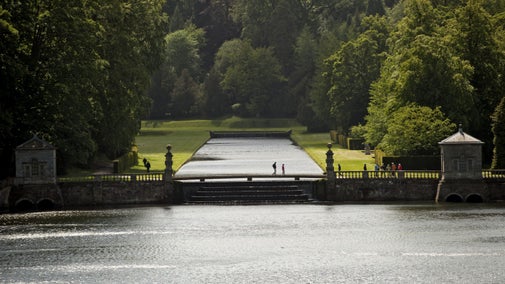
What is a water garden?
Find out how water gardens have evolved with changing tastes, from European inspiration and ornamental canals to the water feature in your garden today.
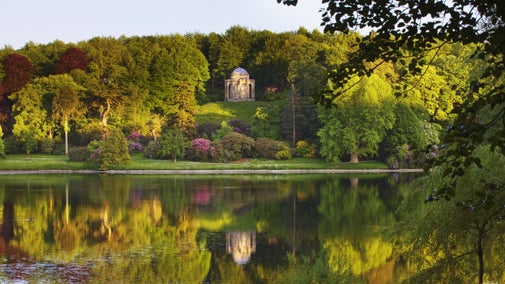
Things to do at Fountains Abbey
The ruins of Fountains Abbey are truly something to behold. Discover what to see when you come face to face with some of the oldest abbey ruins in the country.
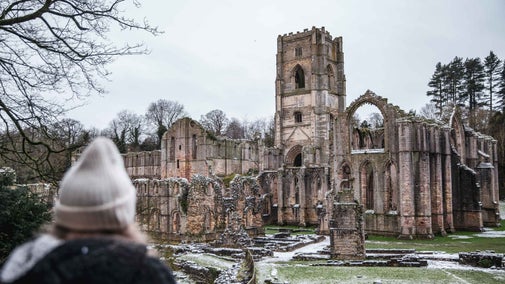
Things to do at Studley Royal
The evocative ruins of the abbey are set beside the grounds of Studley Royal, a medieval deer park in Yorkshire. It was declared Yorkshire’s first World Heritage Site in 1986.

History
Learn about people from the past, discover remarkable works of art and brush up on your knowledge of architecture and gardens.
